Where is Zambia?
About Zambia
The Land
The People
Life and Death
Health, Energy and the Environment
Education and Work
Travel, Communication and the Media






Back to the Flags of Africa page

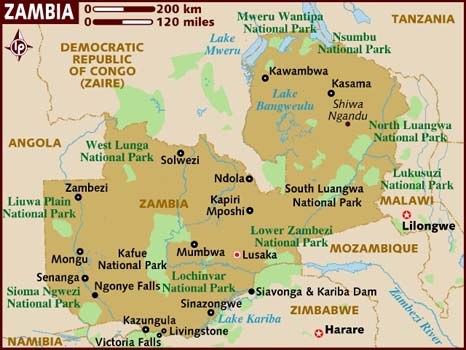


Zambia is a large country in southern Africa.
Zambia is a landlocked country with no coastal borders.
The land is mostly high plateau with some hills and mountains.
The geographical coordinates for the centre of Zambia, also known as lines of latitude and longitude, are:-
Latitude - 15 00
Longitude - 30 00S
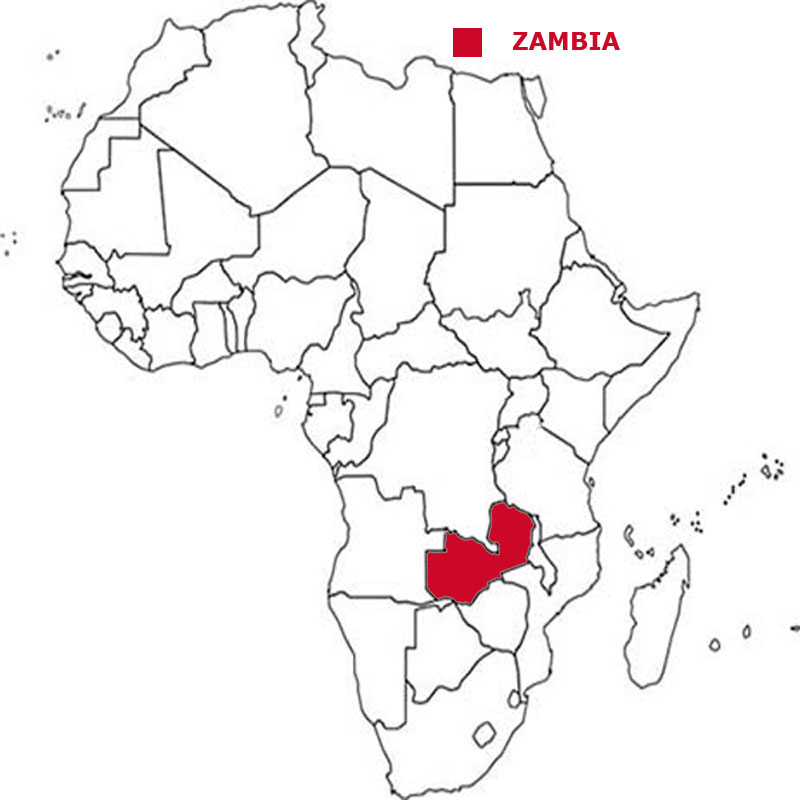

Check the weather in Lusaka now.
This is the time in Lusaka now
 The Zambian flag is green with a panel of three vertical stripes of red, nearer to the flagpole side, black and orange, below a soaring orange eagle. This panel is in the lower right quarter of the flag.
Green stands for the country's natural resources and vegetation, red represents the struggle for freedom, black the people of Zambia, and orange the country's mineral
wealth. The eagle represents the people's ability to rise above the nation's problems
The Zambian flag is green with a panel of three vertical stripes of red, nearer to the flagpole side, black and orange, below a soaring orange eagle. This panel is in the lower right quarter of the flag.
Green stands for the country's natural resources and vegetation, red represents the struggle for freedom, black the people of Zambia, and orange the country's mineral
wealth. The eagle represents the people's ability to rise above the nation's problems
Zambia is a presidential republic with a president as head of state and head of the government.
In elections everyone over the age of 18 can vote.
The currency in Zambia is the kwacha. Zambia is a member of the Commonwealth.
English is the official language.
Hear the National Anthem
These are the anthem words
We have already written our own history of England but are asking schools in Zambia to provide us with a detailed history of
their own country. Check how here.
![]()
![]() Back to the top
Back to the top

The total land area of Zambia is 743,398 sq kms which is the 17th largest in Africa.
Zambia has lakes, rivers and canals which total 9,220 sq kms.
Zambia has boundaries with 8 countries
- Democratic Republic of Congo 2,332 kms
- Angola 1,065 kms
- Malazi 847 kms
- Zimbabwe 763 kms
- Mozambique 439 kms
- Tanzania 353 kms
- Namibia 244 kms
- Botswana 0.15 kms
Zambia has no coastline.
An unnamed hill in the Mafinga Hills at 2,301 metres.
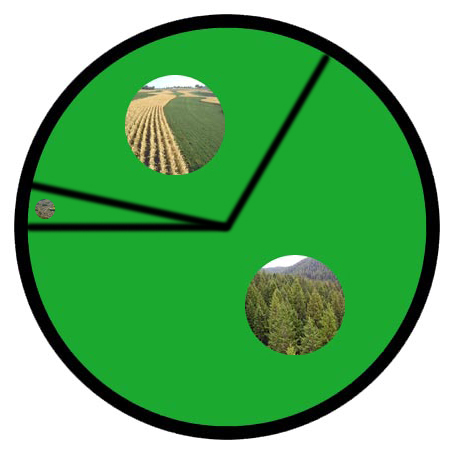

The total population of Zambia is 16.45 million people, making it the 22nd largest country in Africa by population.
Of this number 8.23 million are females and 8.22 million are males.
A person from Zambia is called a Zambian.
To be a citizen of Zambia, one of your parents must be a citizen of Zambia. It is sufficient to be born in Zambia if one parent is a citizen of Zambia.
You have to live in Zambia for 5 years, if an ancestor was a citizen of Zambia, otherwise 10 years residency is required
The largest five cities in Zambia, by population are:-
- Lusaka 1,267,440 people
- Kitwe 400,914
- Ndola 394,518
- Kabwe 188,979
- Chingola 148,564
 Each little Owlbut is 1 person and
the big yellow rectangle is 1 sq km. After a while you can compare countries and see which ones are the most crowded. Remember it is only an average as
more people live closer together in towns and cities than in villages out in the country.
Each little Owlbut is 1 person and
the big yellow rectangle is 1 sq km. After a while you can compare countries and see which ones are the most crowded. Remember it is only an average as
more people live closer together in towns and cities than in villages out in the country.

43.5% of the people live in cities or towns.

The birth rate in Zambia is 41.1 births per 1,000 of population
The death rate in Zambia is 12.0 deaths per 1,000 people.
Check this against the birth rate. If the death rate is higher than the birth rate then
the population will decrease unless immigrants arrive in the country.
There are 53.9 deaths of girls under 1 year per 1,000 of births and 64.6 deaths of boys.
The median age for females is 16.9 and for males is 16.7. The median age is that age which divides the population exactly in half so there are the same number
of people above the median age as below it.
The average age of a woman when she has her first child is 19.2.
The elderly dependency ratio is 4.8. This is the number of elderly people (ages 65+) per 100 people of working age (ages 15-64).
The potential support ratio is 20.8. This is the number of working-age people (ages 15-64) per one elderly person (ages 65+). As a population ages, the potential support ratio tends to fall, meaning there are fewer potential workers to support the elderly.
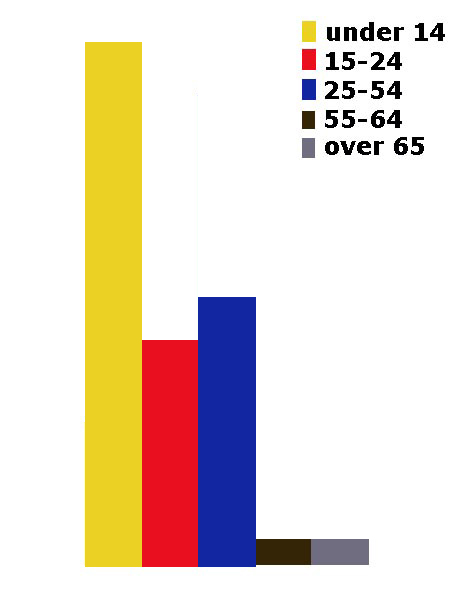
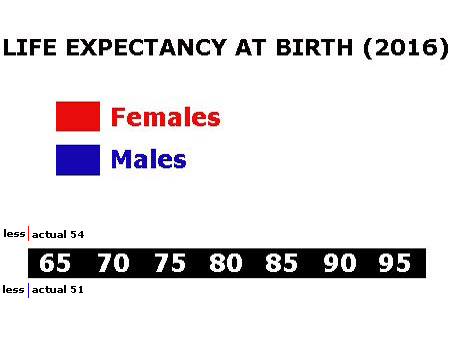

Zambia spends 5.0% of its total income on health care.
There are 0.09 doctors per 1,000 people.
There are 2.0 hospital beds per 1,000 people.
8.1% of the population are estimated as obese.
85.6% of the urban population and 51.3% of the rural population have drinking water that is either piped into their home or they have access to a public tap, a protected borehole, well, spring or
protected rainwater collection facility.
55.6% of the urban population and 35.7% of the rural population have access to a flushing toilet that is connected to a sewer, a pit latrine (that is a
permanent hole in the ground that is looked after) or a composting toilet.
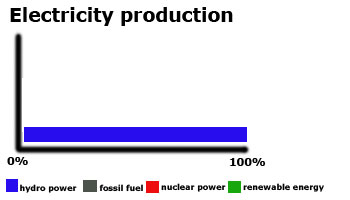
Zambia releases 3.5 million metric tons of carbon dioxide by burning fossil fuels in the process of producing and consuming energy. This puts it as the 26th highest in Africa.

We have no figures for the amount Zambia spends of its total income on education.
Children usually start school at age 7 in Zambia. Primary education is for seven years until age 14 and secondary education can continue till 19. This may be followed
by further education at a university or college.
Generally the school year consists of 3 terms and starts in the middle of January and finishes at the beginning of December. There is usually a 4 week
break beginning in the middle of April and another one beginning in the middle of August.
56% of females and 70.9% of males are able to read and write by the age of 15.
24.0% of all people aged between 16 and 24 are not in work. Among females 24.4% are unemployed while with males 23.6% can't find work.
The total number of people available for work in Zambia is 6.90 million.
 They work in the following sectors.
They work in the following sectors.
- Agriculture includes farming, fishing and forestry work
- Industry includes mining, manufacturing, construction and energy workers
- Services is everything else

There are 8 paved airports in Zambia, which is the 28th highest number in Africa.
![]()
There are 1,237 kilometres of railways in Zambia, the 16th longest in Africa.
![]()
There are 14,454 kilometres of roads in Zambia, which means Zambia is in 18th place for the most kilometres of roads in Africa.
![]()
There are 3 major national newspapers in Zambia.
There are 13.44 million mobile phone users.
1% of the people have a fixed landline.

3.96 million people have access to the internet at home via any device (computer or mobile).


